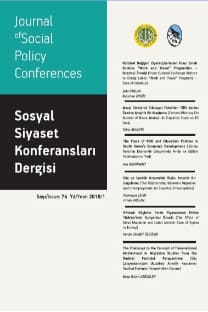ÜST DÜZEY YÖNETİCİLERİN ÜCRETLENDİRİLMESİ VE TÜRKİYE'DEKİ UYGULAMALARIN TESPİTİNE YÖNELİK BİR ARAŞTIRMA
___
Alayoùlu, Nihat (2005). “Stratejik Ücret Yönetimi ve Üst düzey Yöneticilerin Ücretlendirilmesine úliükin Bir AraüW×rma”. ústanbul Üniversitesi Sosyal Bilimler Enstitüsü úületme Anabilim Dal×, únsan Kaynaklar× Yönetimi Bilim Dal×, (Yay×nlanmam×ü doktora tezi).Altmansberger, H.N(Rug) (1999). “Variable Pay: An Overview” pp.199-207. The Compensation Handbook. Ed. by Lance A. Berger, Dorothy R.Berger, New York, McGraw-Hill, 4th Edition.
Armstrong, Michael, (1997), Employee Reward, London, Institute of Personnel and Development.
Ellig, Bruce R., (2002), The Complete Guide to Execute Compensation, New York, McGraw-Hill.
Gomez-Mejia, Luis R.; David Balkin. (1992). Compensation, Organizational Strategy, Firm Performance. Cincinnati-Ohio, South-Western Publishing Company.
Gomez - Mejia, Luis R.; David B. Balkin, Robert L. Cardy, (2001). Managing Human Resources. New Jersey, Prentice-Hall, Inc., 3rd Ed.
Hyman, S. Jeffry, (1999). “Long- Term Incentives”. The Compensation Handbook. Ed.: Lance A. Berger and Dorothy R.Berger, 4th Ed.McGraw-Hill, pp.358-359.
Jensen, M.C, (1993). “The Modern Industrial Revulation, Exit, and the Failure of Internal Control Mechanism”. Journal Finance. vol.48, pp.831-880.
Johnson, Alan M., (1999). “Designing and Implementing Total Executive Compensation Programs”. The Compensation Handbook. Editors: Lance A. Berger and Dorothy R.Berger, 4th Ed.McGraw-Hill.
Lambert, R.A.; D.F. Larcker, (1987). “An Analysis of The Use of Accounting And Market Measures of Performance In Executive Compensation Contracts”. Journal of Accounting Research. Vol. 25, 1987, pp. 85-129.
Martocchio, Joseph J., (2001). Strategic Compensation: A Human Resource Management Approach. Prentice-Hall,Inc., 2nd ed., New Jersey.
Miller, Daniel J. (1997). “CEO Salary Increases Maybe Ratioanal After All: Referents and Contracts in CEO Pay”. Academy of Management Journal. Vol.38, No:5, pp.1361-1385.
Milkovich, G.T.; J.M. Newman, (2002). Compensation. New York, McGraw-Hill, Int., 7th Ed.
Pennings, Johannes (1999). “Executive Compensation Systems: Drivers or Results From Strategic Choices?”, pp.373-389. The Compensation Handbook. Editors: Lance A. Berger and Dorothy R.Berger, 4th Ed.McGraw-Hill.
Pohjola, Eila, (2005). “Executive Compensation. Strategy Perspective”. Helsinki University of Technology, Department of Industrial Engineering and Management. TU-91.167. Seminar in Business Strategy and International Business. January 28th, 2005, <http://www.tuta.hut.fi/ studies /Courses_and_schedules /lsib/TU-91.167 /seminar_papers _2005/ Eila_Pohjola. pdf> (07.03.2005).
Singh, H.; F. Harianto (1989). “Top Management Tenure, Corporate Ownership Structure and The Magnitude of Golden Parachutes”. Strategic Management Journal. Vol.10, pp.143-156.
Schuster, J. R.; P. K. Zingheim (1992). The New Pay: Linking Employee and Organizational Performance, New York, Lexington,. Uyargil, Cavide (1996). Avrupa’da Stratejik únsan Kaynaklar× Yönetimi AraüW×rmas×. 1995 - Türkiye Raporu, ústanbul.
Williams, Valerie L., Stephen E. Grimaldi (1999). “A Quick Breakdown of Strategic Pay”. Workforce. December 1999, Vol. 78, No.12, pp. 72-75.
Zingheim, Patricia K.; Schuster, Jay R. (2000). Pay People Right. San Francisco, JosseyBass Publishers.
- ISSN: 1304-0103
- Yayın Aralığı: Yılda 2 Sayı
- Başlangıç: 1948
- Yayıncı: İstanbul Üniversitesi Yayınevi
